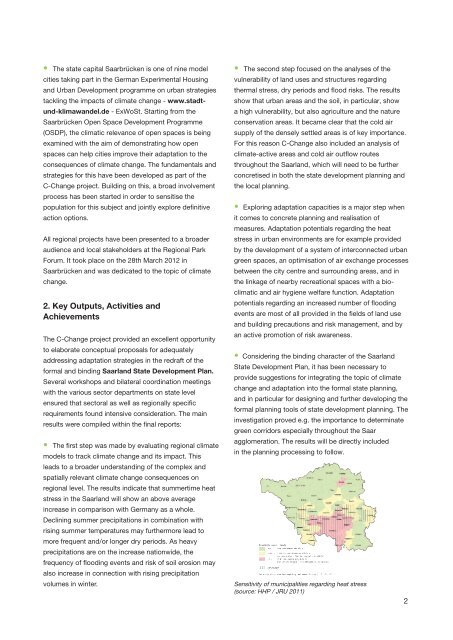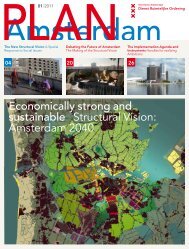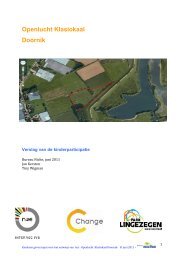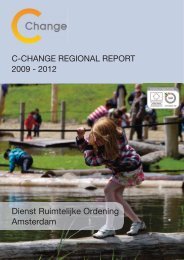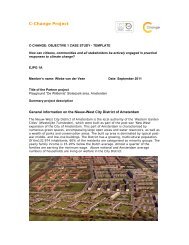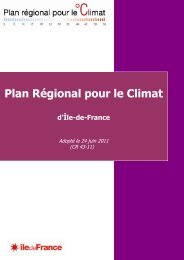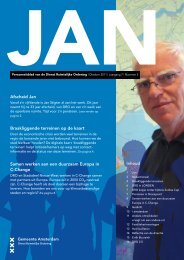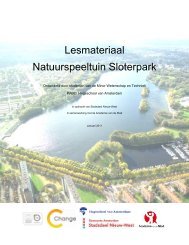Saarland Regional Report - C-Change
Saarland Regional Report - C-Change
Saarland Regional Report - C-Change
Create successful ePaper yourself
Turn your PDF publications into a flip-book with our unique Google optimized e-Paper software.
• The state capital Saarbrücken is one of nine model<br />
cities taking part in the German Experimental Housing<br />
and Urban Development programme on urban strategies<br />
tackling the impacts of climate change - www.stadtund-klimawandel.de<br />
- ExWoSt. Starting from the<br />
Saarbrücken Open Space Development Programme<br />
(OSDP), the climatic relevance of open spaces is being<br />
examined with the aim of demonstrating how open<br />
spaces can help cities improve their adaptation to the<br />
consequences of climate change. The fundamentals and<br />
strategies for this have been developed as part of the<br />
C-<strong>Change</strong> project. Building on this, a broad involvement<br />
process has been started in order to sensitise the<br />
population for this subject and jointly explore definitive<br />
action options.<br />
All regional projects have been presented to a broader<br />
audience and local stakeholders at the <strong>Regional</strong> Park<br />
Forum. It took place on the 28th March 2012 in<br />
Saarbrücken and was dedicated to the topic of climate<br />
change.<br />
2. Key Outputs, Activities and<br />
Achievements<br />
The C-<strong>Change</strong> project provided an excellent opportunity<br />
to elaborate conceptual proposals for adequately<br />
addressing adaptation strategies in the redraft of the<br />
formal and binding <strong>Saarland</strong> State Development Plan.<br />
Several workshops and bilateral coordination meetings<br />
with the various sector departments on state level<br />
ensured that sectoral as well as regionally specific<br />
requirements found intensive consideration. The main<br />
results were compiled within the final reports:<br />
• The first step was made by evaluating regional climate<br />
models to track climate change and its impact. This<br />
leads to a broader understanding of the complex and<br />
spatially relevant climate change consequences on<br />
regional level. The results indicate that summertime heat<br />
stress in the <strong>Saarland</strong> will show an above average<br />
increase in comparison with Germany as a whole.<br />
Declining summer precipitations in combination with<br />
rising summer temperatures may furthermore lead to<br />
more frequent and/or longer dry periods. As heavy<br />
precipitations are on the increase nationwide, the<br />
frequency of flooding events and risk of soil erosion may<br />
also increase in connection with rising precipitation<br />
volumes in winter.<br />
• The second step focused on the analyses of the<br />
vulnerability of land uses and structures regarding<br />
thermal stress, dry periods and flood risks. The results<br />
show that urban areas and the soil, in particular, show<br />
a high vulnerability, but also agriculture and the nature<br />
conservation areas. It became clear that the cold air<br />
supply of the densely settled areas is of key importance.<br />
For this reason C-<strong>Change</strong> also included an analysis of<br />
climate-active areas and cold air outflow routes<br />
throughout the <strong>Saarland</strong>, which will need to be further<br />
concretised in both the state development planning and<br />
the local planning.<br />
• Exploring adaptation capacities is a major step when<br />
it comes to concrete planning and realisation of<br />
measures. Adaptation potentials regarding the heat<br />
stress in urban environments are for example provided<br />
by the development of a system of interconnected urban<br />
green spaces, an optimisation of air exchange processes<br />
between the city centre and surrounding areas, and in<br />
the linkage of nearby recreational spaces with a bioclimatic<br />
and air hygiene welfare function. Adaptation<br />
potentials regarding an increased number of flooding<br />
events are most of all provided in the fields of land use<br />
and building precautions and risk management, and by<br />
an active promotion of risk awareness.<br />
• Considering the binding character of the <strong>Saarland</strong><br />
State Development Plan, it has been necessary to<br />
provide suggestions for integrating the topic of climate<br />
change and adaptation into the formal state planning,<br />
and in particular for designing and further developing the<br />
formal planning tools of state development planning. The<br />
investigation proved e.g. the importance to determinate<br />
green corridors especially throughout the Saar<br />
agglomeration. The results will be directly included<br />
in the planning processing to follow.<br />
Sensitivity of municipalities regarding heat stress<br />
(source: HHP / JRU 2011)<br />
2


